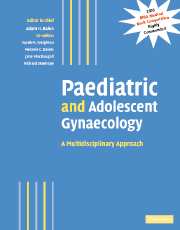Book contents
- Frontmatter
- Contents
- Contributors
- Preface
- Part I Normal development
- Part II Management of developmental abnormalities of the genital tract
- Part III Management of specific disorders
- 18 Disorders of growth and puberty
- 19 Turner's syndrome
- 20 Androgen insensitivity syndromes
- 21 Rokitansky syndrome and other Müllerian anomalies
- 22 The XY female
- 23 The gynaecology of the major genitourinary anomalies
- 24 Congenital adrenal hyperplasia
- 25 Long-term sequelae of genital surgery
- 26 Amenorrhoea
- 27 The polycystic ovary syndrome and adolescent women
- 28 Menstrual disorders in adolescent girls
- 29 Pelvic pain, ovarian cysts and endometriosis in adolescent girls
- 30 Premature ovarian failure and ovarian ageing
- 31 Gynaecological cancers in childhood
- 32 Late reproductive sequelae of treatment for childhood cancer
- 33 Preservation of fertility before cancer therapy
- 34 The management of infertility with surrogacy and egg donation
- 35 Dermatological conditions of the female genitalia
- 36 Vaginal discharge
- 37 Psychological gender development in individuals born with ambiguous genitalia
- 38 Eating disorders in adolescence
- 39 Nutritional amenorrhoea: long-term sequelae
- 40 How to set up a service: how to teach and train
- Index
- Plate section
- References
34 - The management of infertility with surrogacy and egg donation
from Part III - Management of specific disorders
Published online by Cambridge University Press: 04 May 2010
- Frontmatter
- Contents
- Contributors
- Preface
- Part I Normal development
- Part II Management of developmental abnormalities of the genital tract
- Part III Management of specific disorders
- 18 Disorders of growth and puberty
- 19 Turner's syndrome
- 20 Androgen insensitivity syndromes
- 21 Rokitansky syndrome and other Müllerian anomalies
- 22 The XY female
- 23 The gynaecology of the major genitourinary anomalies
- 24 Congenital adrenal hyperplasia
- 25 Long-term sequelae of genital surgery
- 26 Amenorrhoea
- 27 The polycystic ovary syndrome and adolescent women
- 28 Menstrual disorders in adolescent girls
- 29 Pelvic pain, ovarian cysts and endometriosis in adolescent girls
- 30 Premature ovarian failure and ovarian ageing
- 31 Gynaecological cancers in childhood
- 32 Late reproductive sequelae of treatment for childhood cancer
- 33 Preservation of fertility before cancer therapy
- 34 The management of infertility with surrogacy and egg donation
- 35 Dermatological conditions of the female genitalia
- 36 Vaginal discharge
- 37 Psychological gender development in individuals born with ambiguous genitalia
- 38 Eating disorders in adolescence
- 39 Nutritional amenorrhoea: long-term sequelae
- 40 How to set up a service: how to teach and train
- Index
- Plate section
- References
Summary
Surrogacy
Until recently, women born with severe abnormalities of development of the Müllerian duct system have been unable to have their own genetic children. Adoption or childlessness have been their only options. The introduction of gestational or in vitro fertilization (IVF) surrogacy during the 1990s as a treatment option has changed the prognosis for women in this situation. Now, women with congenital absence or severe malformations of the uterus, or hysterectomy and abnormalities of the uterus incurred as a result of trauma or cancer treatment, have a chance of having their own genetic child, albeit gestated by another woman. As IVF surrogacy has become increasingly acceptable as a treatment option, both to the medical profession and to the general public (British Medical Association, 1996; Bromham, 1992, 1995), these young women can now have their own children, provided, as most of them do, they have normally functioning ovaries. However, some who have survived the treatment of a malignancy in childhood may have lost not only their uterine function, but also their ovarian function. This section reviews the indications for IVF surrogacy and the selection and management of women seeking this treatment, particularly relating to those with congenital abnormalities. The following section discusses the use of egg donation.
Indications
The main indications for considering treatment by IVF surrogacy are:
congenital absence or abnormality of the uterus
hysterectomy following malignancy or haemorrhage
recurrent abortion
severe medical problems precluding pregnancy and childbirth
repeated IVF failure.
Congenital absence of the uterus and following hysterectomy are the commonest indications for surrogacy.
- Type
- Chapter
- Information
- Paediatric and Adolescent GynaecologyA Multidisciplinary Approach, pp. 428 - 443Publisher: Cambridge University PressPrint publication year: 2004



